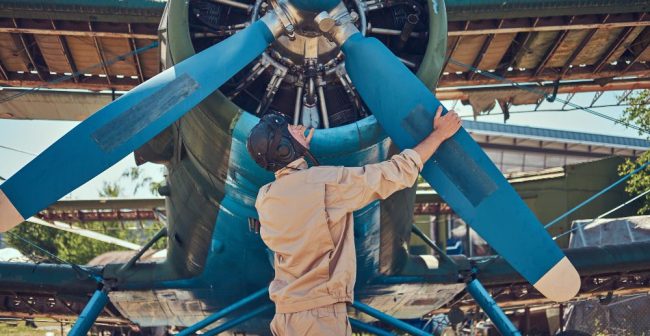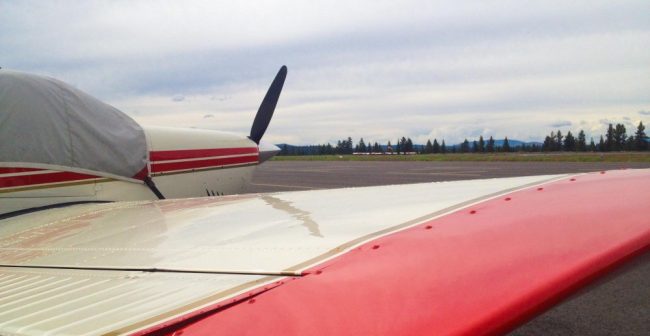AIRCRAFT PARTS

Flap Position Indicator
Flap Position Indicators are critical devices in aviation, providing pilots with accurate information on the position of the aircraft’s wing flaps during all phases of flight. Wing flaps are vital in adjusting lift and drag, directly influencing both safety and performance. Whether during takeoff, landing, or low-speed flight, a reliable Flap Position Indicator ensures that the flaps are properly positioned, allowing the aircraft to operate efficiently.
These indicators are designed to help pilots maintain full control by offering real-time data on the extension or retraction of the wing flaps. This data enables pilots to make informed adjustments, improving overall stability and maneuverability during different flight conditions.
Why Flap Position Indicators Are Crucial for Flight Safety
One of the main functions of Flap Position Indicators is to enhance flight safety by providing clear, reliable data on the flap settings. Incorrect flap positions, especially during critical moments like takeoff and landing, can lead to potentially dangerous situations. With precise indicators, pilots can avoid such risks and ensure safe, smooth operations.
Moreover, Flap Position Indicators optimize the aircraft’s performance. Correctly deployed flaps improve fuel efficiency and allow the aircraft to better handle various speeds and altitudes.
Types of Flap Position Indicators
- Analog Flap Position Indicators: These traditional devices use a dial or gauge to display the flap position in degrees or percentages. They are simple and provide clear visual cues to the pilot.
- Digital Flap Position Indicators: Modern aircraft technology has introduced digital indicators that offer more precise, detailed information, often integrated into the avionics system for seamless monitoring.
Choosing the Right Flap Position Indicator
When selecting a Flap Position Indicator, it’s crucial to consider your aircraft’s specific needs. Ensure the indicator is compatible with your aircraft model and adheres to international safety and quality standards. Additionally, selecting a product that offers ongoing technical support and service is essential for ensuring long-term reliability.
“ Advanced wing flap position sensor technology enhances aircraft control and stability, ensuring every flight is a safe and smooth journey through the skies.”
Questions & Answers
What is a wing flap position sensor and how does it work?
A wing flap position sensor is a device that measures the position of the wing flaps on an aircraft. It works by detecting the angle or position of the flaps and sending this information to the aircraft's control systems, allowing for precise adjustments and better control during various phases of flight.
What is the difference between a wing flap position sensor and a wing position sensor?
A wing flap position sensor specifically measures the position of the wing flaps, which are movable surfaces on the wings used to control lift and drag. A wing position sensor, on the other hand, may refer to sensors that measure the overall position or angle of the wings themselves, though this term is less commonly used in aviation.
How do wing flap position sensors enhance flight safety?
By providing accurate and real-time information about the flap positions, wing flap position sensors help pilots and automated systems make necessary adjustments to maintain optimal flight conditions. This reduces the risk of accidents caused by improper flap settings and enhances overall flight stability.
Are wing flap position sensors easy to install and maintain?
Yes, modern wing flap position sensors are designed for easy installation and maintenance. They are typically robust and durable, requiring minimal upkeep. Regular inspections and calibrations as part of routine aircraft maintenance ensure they function correctly and reliably.
What types of aircraft can benefit from wing flap position sensors?
Wing flap position sensors are beneficial for a wide range of aircraft, from small ultralight planes to large commercial jets. Any aircraft with wing flaps can improve its performance and safety with these sensors.
Contact With Us
Let’s Work Together?
Delivering high-quality parts and components for the aviation, maritime, automotive, and heavy industries. Ensuring reliability and precision in every product.

Have Any Question?
+48 516 494 849

Send Email
contact@e-worldparts.com
Contact Us
Cutting-Edge Technology for Wing Flap Position Sensor
Our advanced wing flap position sensors represent the pinnacle of wing flap monitoring technology, providing pilots with unparalleled precision and clarity essential for safe and efficient flights. By seamlessly integrating cutting-edge technology, these sensors ensure high accuracy and superior reliability under all conditions, offering pilots comprehensive insights into wing flap positions. Whether navigating through turbulent weather or executing precise landing maneuvers, our sensors enhance situational awareness and flight safety, empowering pilots to make informed decisions with confidence.c
Experience a New Level of Control with Our Advanced Wing Position Sensors
Experience a new level of control and performance with our advanced wing flap position sensors, engineered to seamlessly integrate with wing flap controls. Designed for modern cockpits, these sensors prioritize reliability and performance, offering pilots intuitive access to wing flap settings. With clear and precise data on wing flap positions, pilots can optimize aircraft performance for various flight phases, from takeoff to landing. Our sensors provide pilots with the tools they need to enhance flight safety and efficiency, ensuring smooth and precise aircraft operation in every situation.
Plain Flap High-Resolution Sensors
- Unrivaled Visual Precision: Our high-resolution plain flap cockpit displays offer unmatched visual precision, providing pilots with crystal-clear insights into flap positions.
- Tailored for Modern Aviation Demands: Engineered to meet the evolving needs of modern aviation, our displays are specifically designed for precise and reliable plain flap monitoring.
- Enhanced Situational Awareness: Elevate situational awareness with crisp and clear visuals, ensuring pilots have comprehensive information on plain flap configurations for safer and more efficient flight operations.
- Detail-Oriented Technology: Leveraging high-resolution technology, our displays ensure every detail of plain flap movements is visible, empowering pilots with critical decision-making data.
- Performance in Varied Lighting Conditions: Experience consistent performance even in challenging lighting conditions, as our displays maintain clarity and readability to support precise plain flap management.
- Durable Construction: Built to withstand the demands of flight, our displays are constructed for durability and longevity, providing reliable support for plain flap monitoring throughout countless flights.
- Reliable Navigation Assistance: Equip pilots with reliable tools for confident navigation by offering clear and precise information on plain flap positions, thereby enhancing overall flight safety.
- Versatile Upgrade Solution: Whether for ultralight planes or commercial jets, our high-resolution plain flap displays offer a versatile upgrade solution, delivering enhanced functionality and performance across aircraft types.
- Quality Assurance: Witness the difference in quality and performance with our high-resolution cockpit displays, setting new standards for plain flap monitoring in the aviation industry.
- User-Friendly Interface: Featuring an intuitive user interface, our displays make it effortless for pilots to access and interpret plain flap data, contributing to enhanced operational efficiency and pilot confidence.
Reliable Avionics Displays
- Seamless Plain Flap Integration: Our avionics systems seamlessly integrate with plain flap controls, ensuring reliable monitoring and control capabilities.
- Precision Monitoring: Experience precise monitoring of plain flap positions with our avionics systems, offering accurate data to support safe and efficient flight operations.
- Advanced Sensor Technology: Leveraging advanced sensor technology, our systems deliver reliable data on plain flap configurations, enhancing overall flight safety.
- Continuous Monitoring Capability: With continuous monitoring capabilities, our avionics systems ensure constant tracking of plain flap positions, promptly alerting pilots to any deviations.
- Redundancy Features: Incorporating redundancy features, our systems provide backup mechanisms to ensure uninterrupted plain flap monitoring, even in the event of system failures.
- Comprehensive Diagnostic Tools: Equipped with comprehensive diagnostic tools, our avionics systems facilitate proactive maintenance by identifying potential issues with plain flap systems.
- Effortless Integration: Designed for effortless integration into existing cockpit systems, our avionics systems offer hassle-free installation and compatibility with various aircraft models.
- Certified Performance: Our avionics systems undergo rigorous testing and certification processes to ensure compliance with industry standards, guaranteeing reliable performance in critical flight situations.
- Global Pilot Trust: Trusted by pilots worldwide, our avionics systems for plain flap monitoring provide peace of mind and confidence, enabling safe and efficient flights.
- User-Friendly Interface: Featuring a user-friendly interface, our systems make it easy for pilots to access and interpret plain flap data, contributing to enhanced operational efficiency and pilot confidence.
Elevate Your Flight Experience with Our Advanced Wing Flap Position Sensors
Elevate your flight experience with our advanced wing flap position sensors, meticulously designed to enhance situational awareness in the cockpit. Engineered with a focus on reliability and performance, these sensors deliver clear and precise data on wing flap positions, empowering pilots to make informed decisions in real-time. Whether adjusting wing flaps for optimal lift during takeoff or configuring them for smooth descent during landing, our sensors provide pilots with the critical information they need to navigate safely through any flight scenario. Trust in our advanced technology to keep you informed and in control, ensuring safe and efficient flights from departure to arrival.
Optimized Plain Flap Monitoring for Enhanced Flight Performance
Upgrade your aircraft’s capabilities with our advanced displays, tailored for optimized plain flap monitoring. With industry-leading resolution and readability, our displays provide pilots with comprehensive insights into plain flap positions, enabling precise control over aircraft performance. From managing drag reduction during cruise to enhancing lift and stability during approach and landing, our displays offer pilots the essential data they need to maximize flight efficiency and safety. Invest in our advanced technology to unlock new possibilities in aircraft operation, ensuring smooth and reliable flights in any conditions.
Key Features of Wing Flap Position Sensor
| Feature | Description | Benefit |
|---|---|---|
| High Accuracy | Provides precise measurement of wing flap positions | Enhances flight control and stability |
| Real-Time Monitoring | Delivers continuous real-time data on wing flap positions | Allows for immediate adjustments and optimal performance |
| Durable Construction | Built to withstand harsh aviation environments | Ensures long-lasting reliability and performance |
| Advanced Technology | Utilizes state-of-the-art sensors and electronics | Offers superior accuracy and responsiveness |
| Easy Integration | Designed for seamless integration with existing aircraft systems | Simplifies installation and reduces downtime |
| Compatibility | Compatible with a wide range of aircraft types and models | Provides versatile application across different aircraft |
| Lightweight Design | Compact and lightweight construction | Minimizes impact on aircraft weight and performance |
| Low Power Consumption | Operates efficiently with minimal power usage | Reduces overall energy consumption and operational costs |
| Environmental Resilience | Resistant to temperature extremes, moisture, and vibration | Performs reliably under various flight conditions |
| Diagnostic Capabilities | Includes self-check and diagnostic functions | Enhances maintenance efficiency and ensures sensor health |
| Certified Quality | Meets industry standards and certifications | Guarantees compliance with aviation regulations |
| User-Friendly Interface | Provides easy-to-read data output and interfaces with avionics displays | Enhances pilot situational awareness and decision-making |
Explanation of Key Features:
- Type: Wing flap position sensors are available in various configurations, including rotary and linear types, each designed to provide optimal feedback for different aircraft systems. This variety ensures that pilots can select the best sensor type for their specific aircraft and operational requirements.
- Material: Constructed from high-quality materials such as aerospace-grade aluminum and robust composites, wing flap position sensors offer a balance between lightweight design and durability. These materials contribute to the sensor’s long lifespan and reliable performance in harsh aviation environments.
- Actuation: Wing flap position sensors are compatible with hydraulic and electric actuation systems, providing accurate and responsive feedback. This compatibility ensures that the sensors can be seamlessly integrated into various aircraft control systems, enhancing overall aircraft performance.
- Measurement Range: The sensors offer a measurement range of 0° to 90°, allowing for precise monitoring of wing flap positions. This wide range of measurement helps pilots optimize lift and drag during different phases of flight, such as takeoff and landing.
- Installation Time: With an installation time of 1 to 3 hours, wing flap position sensors can be quickly and easily retrofitted onto various aircraft, minimizing downtime and enhancing operational efficiency.
- Maintenance Interval: A maintenance interval of 1,000 flight hours reduces downtime and operational costs, ensuring that the sensors remain in optimal condition with less frequent servicing. This long interval between maintenance checks enhances the reliability of the sensors.
- Operating Temperature Range: The wide operating temperature range of -40°C to 85°C ensures reliable performance in diverse environmental conditions, from arctic cold to tropical heat. This versatility allows the sensors to function accurately in all weather conditions.
- Weight: Weighing between 100 to 300 grams, wing flap position sensors have a minimal impact on the overall aircraft weight. Their lightweight design ensures they do not adversely affect flight performance or fuel efficiency.
- Certification: Compliance with FAA and EASA standards guarantees that wing flap position sensors meet all necessary safety and performance criteria. This certification provides peace of mind to operators and maintenance crews, ensuring the sensors are safe and reliable.
- Additional Features: Features such as anti-corrosion coatings and self-diagnostic systems enhance safety and ease of maintenance. Anti-corrosion coatings protect the sensors from environmental damage, while self-diagnostic systems allow for early detection of issues, ensuring timely maintenance and repairs.



